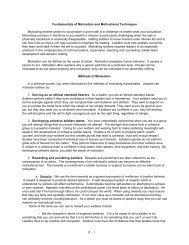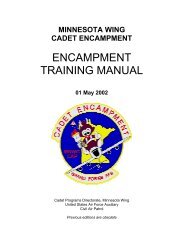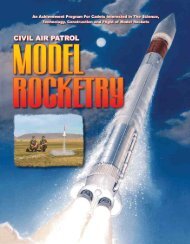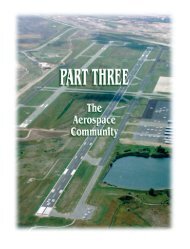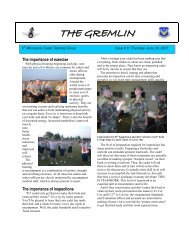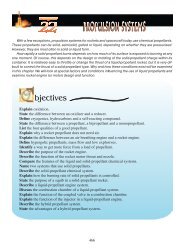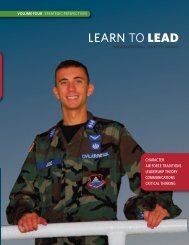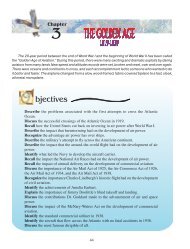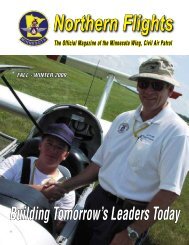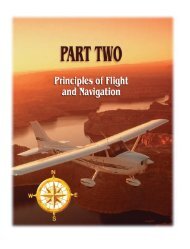Chapter 16 - Aerospace Organizations - Civil Air Patrol
Chapter 16 - Aerospace Organizations - Civil Air Patrol
Chapter 16 - Aerospace Organizations - Civil Air Patrol
Create successful ePaper yourself
Turn your PDF publications into a flip-book with our unique Google optimized e-Paper software.
maintenance of the airway system over the United States, including all aids to air navigation. It alsoauthorized the Department of Commerce to develop a system of regulations, which would provide safetyin air commerce. The Bureau of <strong>Air</strong> Commerce was established within the Department of Commerceto carry out these programs.The first safety regulations developed were the requirementsfor registration and licensing of aircraft, and the certification andmedical examination of all pilots. The Bureau of <strong>Air</strong> Commercedid much to improve aviation radio and other navigational aids.It also promoted airport construction throughout the country, butit did not provide financial assistance for building airports.<strong>Civil</strong> Aeronautics Act - 1938. By 1938, the carrying ofairmail and passengers had increased significantly, making newlegislation necessary. The new law governing civil aviation wascalled the <strong>Civil</strong> Aeronautics Act of 1938. This act placed all airtransportation regulations, both economic and safety, under threeseparate agencies. The first was the <strong>Civil</strong> Aeronautics Authority, which established policies governing thesafety and economics of air transportation. The second was the Office of the Administrator of Aviation,which was formed to carry out the safety policies of the <strong>Civil</strong> Aeronautics Authority. The third was the<strong>Air</strong> Safety Board, which was formed to investigate aircraft accidents.In 1940, the <strong>Civil</strong> Aeronautics Act was amended, and the three agencies were reduced to two. The<strong>Civil</strong> Aeronautics Board (CAB) took over the policy-making responsibility in both safety and economicmatters. It also assumed the accident investigation duties of the <strong>Air</strong> Safety Board. The second agencywas the <strong>Civil</strong> Aeronautics Administration (CAA). It was charged with executing the safety regulationsdeveloped by the CAB and with operation of the airway system. The CAA was placed under theDepartment of Commerce.Federal <strong>Air</strong>port Act - 1946. The Federal <strong>Air</strong>port Act of 1946 provided for the CAA to design asystem of airports throughout the United States using federal funds for their development. This legislationwas needed because of the tremendous increase in aviation activity after World War II. The Federal<strong>Air</strong>port Act of 1946 was amended several times, but it remained in effect until the <strong>Air</strong>port and <strong>Air</strong>wayDevelopment Act of 1970 was passed in June 1970.Federal Aviation Act - 1958. The <strong>Civil</strong> Aeronautics Act remained in effect for 20 years (1938- 1958) before the regulation of civil aviation was again changed by the Federal Aviation Act of 1958.The biggest change provided by this act was that the CAA, which was part of the Department of Commerce,became an independent agency—the Federal Aviation Agency (FAA). The Federal AviationAct of 1958 removed the responsibility for developing safety regulations from the CAB and gavethis responsibility to the newly formed FAA. In effect, this gave the FAA the responsibility for bothdeveloping safety regulations and enforcing them. The CAB retained its responsibility for economicregulation of air commerce and the investigation of aircraft accidents.Department of Transportation Act - 1966. The final change in the status of the FAA came withthe Department of Transportation Act, passed in 1966. This act placed all public transportation under asingle manager, the Department of Transportation. The duties and responsibilities of the FAA remainedunchanged, but the name was changed to the Federal Aviation Administration. During its history, the354



